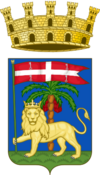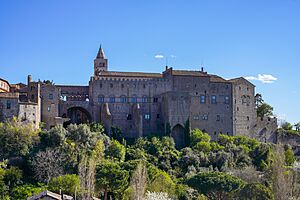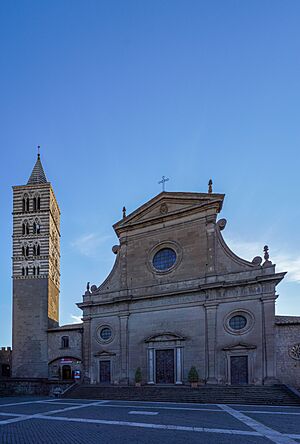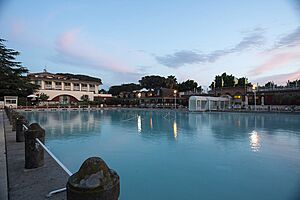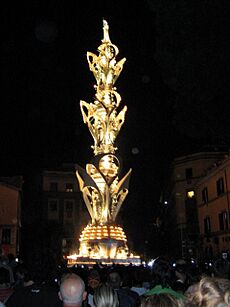Viterbo facts for kids
Quick facts for kids
Viterbo
|
|||
|---|---|---|---|
| Comune di Viterbo | |||
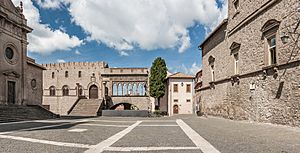
Piazza di San Lorenzo and the loggia of the Papal Palace
|
|||
|
|||
| Country | Italy | ||
| Region | Lazio | ||
| Province | Viterbo (VT) | ||
| Frazioni | Bagnaia, Fastello, Grotte Santo Stefano, La Quercia, Montanciano, Montecalvello, Monterazzano, Sant'Angelo, San Martino al Cimino, Vallebona | ||
| Area | |||
| • Total | 406.23 km2 (156.85 sq mi) | ||
| Elevation | 326 m (1,070 ft) | ||
| Population
(30 September 2017)
|
|||
| • Total | 67,804 | ||
| • Density | 166.910/km2 (432.296/sq mi) | ||
| Demonym(s) | Viterbesi | ||
| Time zone | UTC+1 (CET) | ||
| • Summer (DST) | UTC+2 (CEST) | ||
| Postal code |
01100
|
||
| Dialing code | 0761 | ||
| Patron saint | Saint Rose of Viterbo and St. Lawrence the Martyr | ||
| Saint day | 4 September; 10 August | ||
Viterbo is a historic city in the Lazio region of Italy. It is the capital of the province of Viterbo. The city is about 80 kilometers (50 miles) north of Rome. It is surrounded by the Monti Cimini and Monti Volsini mountains.
Viterbo's old town is special because it is still surrounded by its original medieval walls of Viterbo. These walls were built in the 11th and 12th centuries. You enter the city through old gates.
Besides farming, Viterbo is known for its pottery, a type of stone called peperino, and wood. The city also holds Italy's gold reserves. It has an important art academy and the University of Tuscia. The Italian Army's Aviation Command has its main office and training center here. Viterbo is also famous for its warm natural springs, which attract many visitors.
Contents
Discovering Viterbo's Past
The city of Viterbo was first mentioned in the 8th century AD as Castrum Viterbii. It was fortified in 773 by the Lombard King Desiderius. He tried to conquer Rome, but failed. When the popes started to support the Franks, Viterbo became part of the Papal States. However, emperors often challenged this control. By 1095, Viterbo became a free city, known as a comune.

Viterbo and the Popes
In times when popes had trouble in Rome, Viterbo became their favorite place to stay. This started with Pope Eugene III in 1145. In 1164, Frederick Barbarossa made Viterbo the home of his rival pope, Antipope Paschal III. A few years later, he called Viterbo a "city" and used its soldiers against Rome.
Viterbo grew bigger in 1172. It destroyed the old city of Ferento and took over other lands. During this time, Viterbo was a rich and successful city. It was one of the most important in Central Italy, with a population of nearly 60,000 people.
In 1207, Pope Innocent III held a meeting in Viterbo's cathedral. However, the city later faced problems. It was seen as a place where heretics (people with beliefs different from the main church) lived. The city was even defeated by the Romans. But in 1210, Viterbo managed to defeat Emperor Otto IV. It was then at war with Rome again.
Changes in Power
In the 13th century, powerful families like the Gatti and Di Vico families ruled Viterbo. Frederick II tried to make Viterbo join his side in 1240. But when the citizens kicked out his German troops in 1243, he tried to attack the city, but failed. After that, Viterbo always supported the popes.
Between 1257 and 1261, Pope Alexander IV lived in Viterbo and also died there. His successor, Urban IV, was chosen in Viterbo.
From 1266 to 1268, Clement IV used Viterbo as his base. He fought against the Hohenstaufen family. Other popes chosen in Viterbo included Gregory X (1271) and John XXI (1276). Pope John XXI sadly died in the papal palace when the library ceiling fell on him. Nicholas III and Martin IV were also chosen here.
The people of Viterbo were not happy when a foreign pope, Martin IV, was chosen. They invaded the cathedral where the election was happening and arrested two cardinals. Because of this, the popes avoided Viterbo for 86 years.
Later History
Without the popes, the city fell under the control of the Di Vico family. In the 14th century, Giovanni di Vico created a large area of control. But his power was broken by Cardinal Gil de Albornoz in 1354. The cardinal was sent by the popes to get back the Papal States. He also built a castle in Viterbo.
Viterbo became part of Italy in 1871. In 1927, it became a provincial capital.
During World War II, Viterbo was occupied by German forces. It was heavily bombed by the Allies between 1943 and 1944. A third of the city was destroyed or badly damaged. Many historical buildings were harmed, and 1,017 civilians died. Recently, in March 2024, an old unexploded bomb was found. This caused over 30,000 people to be evacuated until it was safely removed.
Viterbo's Climate and Weather
Viterbo has a hot-summer Mediterranean climate. This means it has hot, dry summers and mild, wet winters. The average yearly temperature is about 14.5°C (58°F). August is the hottest month, averaging 24.4°C (76°F). January is the coldest, with an average of 6.4°C (43°F).
The city gets about 870 millimeters (34 inches) of rain each year. November is the wettest month, while July is the driest.
| Climate data for Viterbo, elevation: 300 m or 980 ft, 1991–2020 normals, extremes 1955–present | |||||||||||||
|---|---|---|---|---|---|---|---|---|---|---|---|---|---|
| Month | Jan | Feb | Mar | Apr | May | Jun | Jul | Aug | Sep | Oct | Nov | Dec | Year |
| Record high °C (°F) | 19.3 (66.7) |
22.3 (72.1) |
26.5 (79.7) |
27.9 (82.2) |
34.3 (93.7) |
40.3 (104.5) |
40.1 (104.2) |
40.1 (104.2) |
36.8 (98.2) |
29.7 (85.5) |
25.3 (77.5) |
19.9 (67.8) |
40.3 (104.5) |
| Mean daily maximum °C (°F) | 10.6 (51.1) |
11.9 (53.4) |
14.7 (58.5) |
17.9 (64.2) |
22.4 (72.3) |
27.4 (81.3) |
31.2 (88.2) |
31.3 (88.3) |
26.0 (78.8) |
20.7 (69.3) |
15.0 (59.0) |
11.2 (52.2) |
20.0 (68.0) |
| Daily mean °C (°F) | 6.4 (43.5) |
7.1 (44.8) |
9.4 (48.9) |
12.3 (54.1) |
16.3 (61.3) |
20.8 (69.4) |
24.0 (75.2) |
24.4 (75.9) |
20.1 (68.2) |
15.6 (60.1) |
10.7 (51.3) |
7.1 (44.8) |
14.5 (58.1) |
| Mean daily minimum °C (°F) | 2.2 (36.0) |
2.2 (36.0) |
4.0 (39.2) |
6.7 (44.1) |
10.2 (50.4) |
14.2 (57.6) |
16.9 (62.4) |
17.5 (63.5) |
14.3 (57.7) |
10.5 (50.9) |
6.3 (43.3) |
3.1 (37.6) |
9.0 (48.2) |
| Record low °C (°F) | −12.7 (9.1) |
−10.2 (13.6) |
−9.2 (15.4) |
−6.2 (20.8) |
−2.2 (28.0) |
4.2 (39.6) |
6.4 (43.5) |
8.4 (47.1) |
3.1 (37.6) |
−1.1 (30.0) |
−11.2 (11.8) |
−11.8 (10.8) |
−12.7 (9.1) |
| Average precipitation mm (inches) | 53.1 (2.09) |
88.6 (3.49) |
60.0 (2.36) |
65.4 (2.57) |
68.0 (2.68) |
46.2 (1.82) |
30.6 (1.20) |
42.3 (1.67) |
114.7 (4.52) |
89.7 (3.53) |
127.1 (5.00) |
84.2 (3.31) |
869.9 (34.25) |
| Average precipitation days (≥ 1.0 mm) | 6.47 | 6.40 | 6.47 | 7.47 | 6.90 | 4.33 | 2.70 | 2.90 | 5.93 | 7.37 | 9.20 | 8.00 | 74.14 |
| Average relative humidity (%) | 74.5 | 70.6 | 69.6 | 70.1 | 69.2 | 66.1 | 62.5 | 62.8 | 67.8 | 73.3 | 77.2 | 76.1 | 70.0 |
| Average dew point °C (°F) | 1.0 (33.8) |
0.8 (33.4) |
2.8 (37.0) |
5.4 (41.7) |
9.5 (49.1) |
12.3 (54.1) |
14.0 (57.2) |
14.6 (58.3) |
12.2 (54.0) |
9.7 (49.5) |
5.5 (41.9) |
2.3 (36.1) |
7.5 (45.5) |
| Mean monthly sunshine hours | 156.6 | 174.4 | 205.2 | 219.0 | 278.4 | 299.7 | 338.2 | 317.1 | 239.4 | 191.9 | 150.0 | 145.7 | 2,715.6 |
| Source 1: Istituto Superiore per la Protezione e la Ricerca Ambientale (temperature) | |||||||||||||
| Source 2: NOAA (dew point 1981-2010) Source 3: Temperature estreme in Toscana (extremes) | |||||||||||||
Exploring Viterbo's Attractions
Viterbo's historic center is one of the best preserved medieval towns in central Italy. Many old buildings, especially churches, are built on ancient ruins. You can see large stones from these older structures. Viterbo is also known for its 'profferli'. These are unique external staircases found on many medieval houses. The San Pellegrino quarter has many of them.
- Palazzo dei Papi (Papal Palace): This is Viterbo's main attraction. Popes lived here for about 20 years in the 13th century. It was also a safe place for them when there was trouble in Rome. Some columns in the palace were taken from an old Roman temple.
- Cathedral of San Lorenzo: This main church was first built in a Romanesque style. It was rebuilt from the 16th century onwards. It was badly damaged by bombs in 1944. The beautiful Gothic bell tower was built in the early 14th century. The church holds the tomb of Pope John XXI.
- Palazzo Comunale (Town Hall), Palazzo del Podestà, and Palazzo della Prefettura: These three important buildings are around the main square, Piazza del Plebiscito. The Town Hall has 17th-century and Baroque paintings.
- Palazzo Farnese: This 14th-15th century palace was the childhood home of Alessandro Farnese, who later became Pope Paul III.
- Medieval Churches: Viterbo has several old Romanesque churches, including Santa Maria Nuova (11th century), San Sisto (9th century), and San Giovanni in Zoccoli (11th century).
- San Francesco: This Gothic church was built over an old Lombard fortress. It has the tomb of Pope Adrian V, who died in Viterbo in 1276.
- Sanctuary of Santa Rosa: This church is a 19th-century building. Every year, a new "Macchina di Santa Rosa" (a tall, decorated tower) is displayed here.
- Museo Civico (City Museum): This museum has ancient items from prehistoric and Roman times. It also has a picture gallery with works by famous artists.
- Orto Botanico dell'Università della Tuscia: This is a botanical garden run by the university.
Viterbo's Famous Baths
West of Viterbo, in the Arcione River valley, are many natural springs. These springs have been known for their healing waters since Etruscan and Roman times. You can still see the impressive ruins of a large Roman bath. Even the famous poet Dante Alighieri mentioned the "Bullicame" (bubbling place) springs in his work.
Near the Bullicame is the Terme dei Papi, or "Bath of the Popes." This place has been used for bathing since the Middle Ages. It was once known as the Bagno della Crociata. In the 15th century, Pope Nicholas V ordered a grand bath palace to be built here. It was so magnificent that it looked like a royal residence.
The bath house was like a fortress, with high towers. This was important because it was outside Viterbo and needed protection. Popes after Nicholas V continued to build and improve the baths. Even though the building was damaged over time, especially during World War II, much of the original structure from the 15th century still remains today.
Military Presence in Viterbo
Viterbo has become an important center for military aviation. This is because it is close to Rome. The Air Force base, now called Rome Viterbo Airport, opened in the 1930s and is still used for military purposes. The Army Aviation Command headquarters and its training school are both located here. The Army's training school for non-commissioned officers (NCOs) is also in the city.
Viterbo's Culture and Traditions
Notable People from Viterbo
Many interesting people have come from Viterbo or lived there:
- Leonardo Bonucci (born 1987), a famous footballer.
- Angelo Peruzzi, another well-known footballer.
- Bartolomeo Cavarozzi (1587–1625), a painter.
- Saint Crispin of Viterbo, a religious figure.
- Saint Rose of Viterbo (1233–1251), the patron saint of the city.
Patron Saints of Viterbo
St. Rose is the main patron saint of Viterbo. Legend says she helped the city in the 1250s. Saint Lawrence is the male patron saint.
The Macchina di Santa Rosa
Every year, on September 3rd, Viterbo celebrates the "Macchina di Santa Rosa." This is a huge, artistic, lighted tower. It is about 30 meters (98 feet) tall and weighs between 3.5 and 5 tonnes. It is made of iron, wood, and papier-mâché. At the top, there is a statue of the patron saint.
One hundred men from Viterbo, called Facchini, carry this giant tower. They carry it from Porta Romana through the main streets of the city. All the street lights are turned off for the event. They stop at seven churches for blessings. The journey ends with a difficult climb up to Piazza di Santa Rosa, where the tower stays. A new design for the Macchina is chosen every few years.
Getting Around Viterbo
Viterbo has regional trains that connect it to Rome. You can catch trains from stations like Ostiense, Trastevere, and S. Pietro in Rome. Sometimes, trains also leave from Termini station. Porta Romana is the train station that serves Viterbo's old city center.
Learning in Viterbo
The city is home to the Tuscia University, which was started in 1979. Students from the School Year Abroad's Italy program also study here. Their school is in a 16th-century palace on Via Cavour.
Viterbo's Sister Cities
Viterbo is connected with several other cities around the world:
 Binghamton, New York, United States
Binghamton, New York, United States Albany, New York, United States
Albany, New York, United States Santa Rosa de Viterbo, São Paulo, Brazil
Santa Rosa de Viterbo, São Paulo, Brazil Gubbio, Perugia, Umbria, Italy
Gubbio, Perugia, Umbria, Italy Palmi, Reggio Calabria, Calabria, Italy
Palmi, Reggio Calabria, Calabria, Italy Nola, Naples, Campania, Italy
Nola, Naples, Campania, Italy Sassari, Sassari, Sardinia, Italy
Sassari, Sassari, Sardinia, Italy Campobasso, Campobasso, Molise, Italy
Campobasso, Campobasso, Molise, Italy Springfield, Massachusetts, United States
Springfield, Massachusetts, United States
Images for kids
See also
 In Spanish: Viterbo para niños
In Spanish: Viterbo para niños



